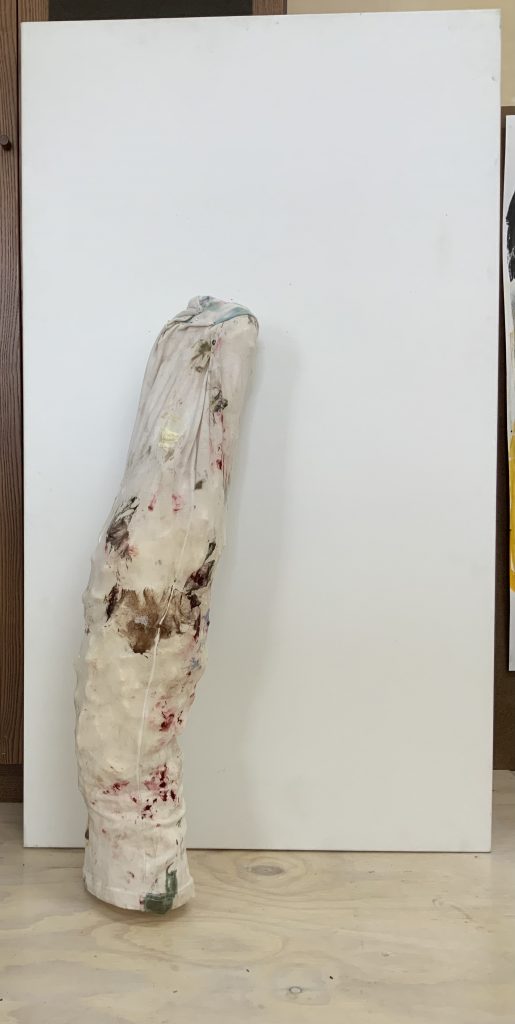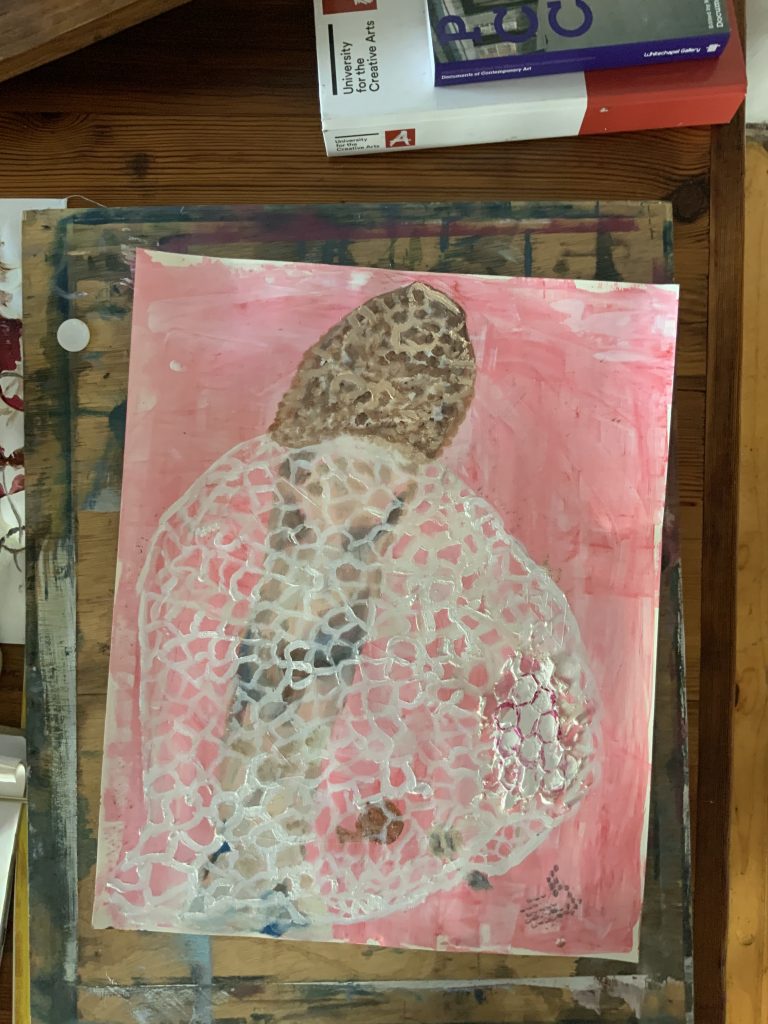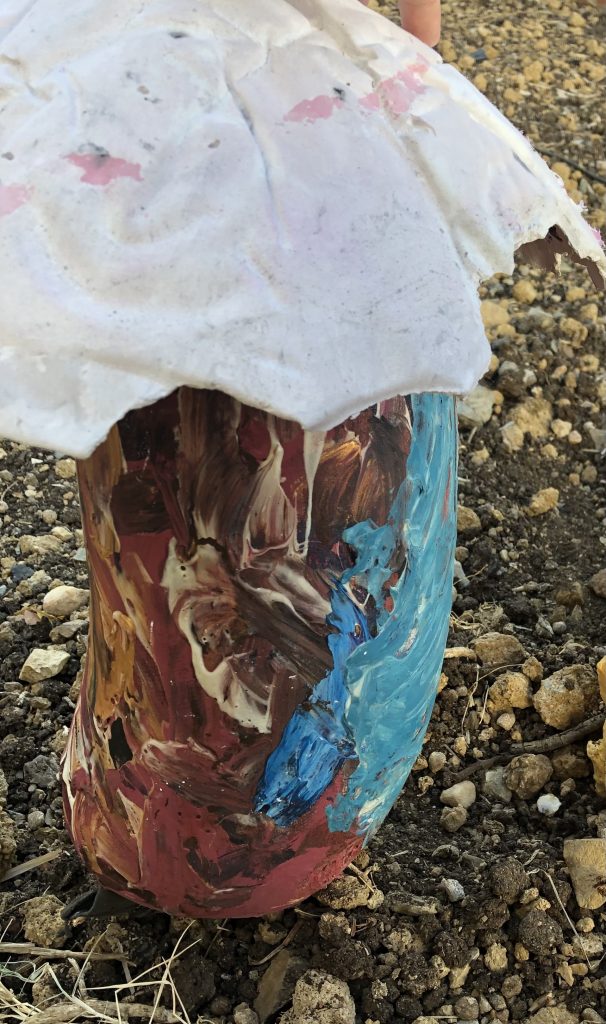REFLECTIVE EXERCISE
EXERCISE 1.2. Relationships with materiality
In the study guide: Consider the following quote of Lange-Berndt (2015:13) in relation to your own practice:
“What does it mean to give agency to the material, to follow the material and to act with the material?”
CONTEXTUAL FOCUS
When Lange-Berndt (2015:14) writes that to ‘follow material means to enter a true maze of meanings, where on encounters terms such as matter, materials, materiality, Stoff, substance or medium, I am aware of this complexity which is entangled in many ways in language, philosophical traditions, art history, and even modern technology. Is Lange-Berndt trying to get to the point of material complicity – namely that material talks or have vibrance to quote Bennet in Vibrant Matter? I like the idea that materials are always in a process of becoming – it makes me feel connected to this world of things and materials, meaning to acknowledge the non-human. I see this view on agency that it is distributed across heterogeneous assemblages, and that the sum is greater than their parts (separately). On page 16 Lange-Berndt (2015:16) writes about things that are often practised ‘long before they are written about’, and she refers to artists, designers, and architects – not academics. I understand this as this connection with materials, like understanding its history, meanings in everyday use, or engaging with people in other disciplines. I am thinking about my interest in fungi and learning from mycologist and biologists, or mushroom hunters (technologists) – this shows a path that is not linear.
Shelldrake (Entangled Life) explains mycelium as polyphony in bodily form – how the song explores the sound for itself, everyone is free to wander, but it is not separate from each other as this song form emerges. In this part, he tells how the Bake Pygmies in the Central African Republic collect mushrooms whilst singing in a polyphone – no leader. This growing system of mycelium and fungi challenges my ideas about individuality and relationships or interactions with organisms around me. I look at the fungi and the mycelia, to me they are vital agents in my own artistic experiments and collaboration project which could lead to an online exhibition. I like the idea of being a collective and challenging anthropocentric form of thinking. I came upon the ideas of anthropologist, Dr Natasha Myers, called Plantrophoscene, which I would like to research more.
When I look at the artworks I have made during this course I have to describe them as material objects, which involved a process of making with a range of materials (like having different qualities and compositions) and then have another process of how it was received and judged as artworks. These works could mostly be viewed as aesthetic, or contextual – and in this way, I could also explore their agency by giving them a life of their own. In this way, I think the way the work is interpreted, different meanings made, not always the meaning that the artist intended. I understand that one can say this is a human-centric approach, but the fact that an object could end up with new meanings, as well as the way it will impact the viewer or even in the public realm (or on social media, like Instagram).

I want to share an example. I made an object (Fig. 1) with foam, and moulded it into an old piece of clothing (the leg of an old white trouser). In this way, I could manipulate the form, length and size. I decided not to take the fabric off the object as the colours and texture resembled the object I wanted to make – a mushroom stem but in an abstracted way. This means I wanted to instil a purpose/meaning in this object. I made a painting and used this object as my model, see the image below. A comment on social media was that it looked like a snake. I do see the snake-like attributes, and not what I intended. It could be in the way we see and what the images ‘do’ to us – can a mushroom remind us of a snake, yes I believe it can, as we all come with different experiences to a work. I recently saw an image on social media of mushrooms that looked like baby octopuses. This experience reminds me of Roland Barthes, namely that experience lies with the audience. It takes me to language compared to experience and when art can get into that liminal space, does it matter that somebody understands/interprets in this case? Is this art? I am doubting my composition – scale.
I think the other thought upon looking at the image is that it shows the phallic structure of the fungi. I see phallic representation as a constructed sign and do ask myself does this mean my work could be genedered? The scientific name of the mushroom I refer to in this work, is phallus indusiatus. I do not think my intentions when making an object, are ever the only option – the materiality of the object cannot be denied some agency because I as a human created it.
I decided to read a bit more about symbolic meaning behind the use of phallus, which normally would refer one to either Freud or Lacan. My discovery was the ideas of Judith Butler who discuss that any number of things might come to stand in for the phallus, a multiple of possibilities and de-heterosexing it. (does it take away the dualism in male/female?) I also came upon the work of Rixta van der Molen. This artist challenge the dualistic possibilities of the phallic object. She describes phallic objects as something which is penetrating. She associates it with violence because these objects take up more space than anything else. She refers to architecture and say these objects are obvious, eye-catching and out in the open. I do think about the skirt around the mushroom – as the feminine side? With my tongue in the cheek I came to the conclusion that just like an erection cannot be hold up for ever, the mushroom too also does not last long, and thus it speaks of temporality and not gendering or the idealised identity in which power and dominance plays a role.

Can I consider that the object claimed its own life histories going beyond what I have anticipated or intended? I do see this matter as dynamic and in a state of becoming. I consider how the physical paint and other materials I used contributed to the thing I made – its effects. I feel it brings a connection between making (art/culture) and nature. I wonder about size, scale, shape when I consider these objects as mushrooms.
I have worked with a range of materials in this course as the projects explored gesture, alternative painting tools, thinking whilst making, by considering movement and bodily actions led to using inks and action painting. I considered bigger brushes, ink, and different surfaces. I liked the texture of the Japanese/Chinese paper and Sumi brushes. The work about Still life and sculpture or 3 d work and exploring not only the pictorial space but also physical space around a work, made me consider other materials such as clay, foam, plastic, plaster of Paris, paper, wire, and rope. Working on a larger scale became a challenge I still need to do with confidence. The foam challenged me around issues of control , being soft when you start out. I had to plan ahead in terms of manipulating size and form. It reminds of the throwing of paint as gesture.

Thinking about the messiness of materials when I think of my practice during the making of this part. My feet and hands were stained with enamel paint, not to even talk about my studio floor! I love to work with my hands getting messy in the plaster of Paris, clay or with Charcoal or soft Pastels. Plaster of Paris reminds me of clay, but it dries quickly and I do not need a kiln. I think the tactility and fragility of the material are part of this enjoyment in my making and manipulating the material when it is still wet and soft. I do not always feel I have a lot of control and need to let the material show me – this could take time and labour and is part of what we would call experience. I think I can call this the stage of plasticity of the material. I looked at the history of this material:
- Made of gypsum, a rocklike mineral known chemically as hydrous calcium sulphate (CaSO42H2O)
- It is found in many parts of the world, usually combined with impurities such as clay, limestone, and iron oxides.
- In its pure form gypsum is a white, chalk-like material but in combination with impurities, it may be grey, brown or pinkish.
- Relatively pure calcined gypsum is known as Plaster of Paris, after the huge beds of it that underlie the city of Paris where it was mined in abundance in the late nineteenth and early twentieth centuries.
The use of wire came with challenges of using tools like a cutter and creating form was more difficult. I feel more comfortable that the work on paper or canvas will be easy to develop as 3d objects. I love that objects can morph and show a life of their own when placed in space or painted or used as a prop or stand-in for something else. Painting on the painted Venda cloth opened my idea about the history of materials I work with and that even a found object has a history. Appadurai (1986, p28) talks about the diversion of commodities, and that in the logic of found art, “the everyday commodity is framed and aestheticized.” Can one assume that Appadurai is showing us that the relationship of objects with each other, and with people, is not static?
“Assemblages are ad hoc groupings of diverse elements, of vibrant materials of all sorts. Assemblages are living, throbbing confederations that are able to function despite the persistent presence of energies that confound them from within. They have uneven topographies, because some of the points at which the various affects and bodies cross paths are more heavily trafficked than others, and so power is not distributed equally across its surface. Assemblages are not governed by any central head: no one materiality or type of material has sufficient competence to determine consistently the trajectory or impact of the group. The effects generated by an assemblage are, rather, emergent properties, emergent in that their ability to make something happen (a newly inflected materialism, a blackout, a hurricane, a war on terror) is distinct from the sum of the vital force of each materiality considered alone. Each member and proto-member of the assemblage has a certain vital force, but there is also an effectivity proper to the grouping as such: an agency of the assemblage.’ (Bennett, 2010: 23,24)
LIST OF ILLUSTRATIONS
Fig. 1 Stander, Karen. (2021) Made object [Expansion foam and cotton fabric] In possession of the author: Langvlei, Riebeeck West.
Fig. 2 Stander, Karen. (2021) Painting [mushroom painting] In possession of the author: Langvlei, Riebeeck West.
Fig. 3 Stander, Karen. (2021) Foam object [expansion foam and paint] In possession of the author: Langvlei, Riebeeck West.
BIBLIOGRAPHY
Bennet, Jane. (2010). Vibrant Matter downloaded from OCA library and saved as pdf. pp 23,24
Lange-Berndt, Petra. (2015) Introduction, How to be Complicit with Materials from ed. Lange-Berndt, Petra, Materiality, Documents of Contemporary Art, London: Whitechapel Gallery and the MIT Press. pp. 1 – 20.
Scher, Sarah, 2012 . Markers of Masculinity: Phallic Representation in Moche Art. Read online at: https://doi.org/10.4000/bifea.520 (Accessed on 8 August 2022)
https://research.gold.ac.uk/id/eprint/1551/1/EDU_Paechter_2006a.pdf